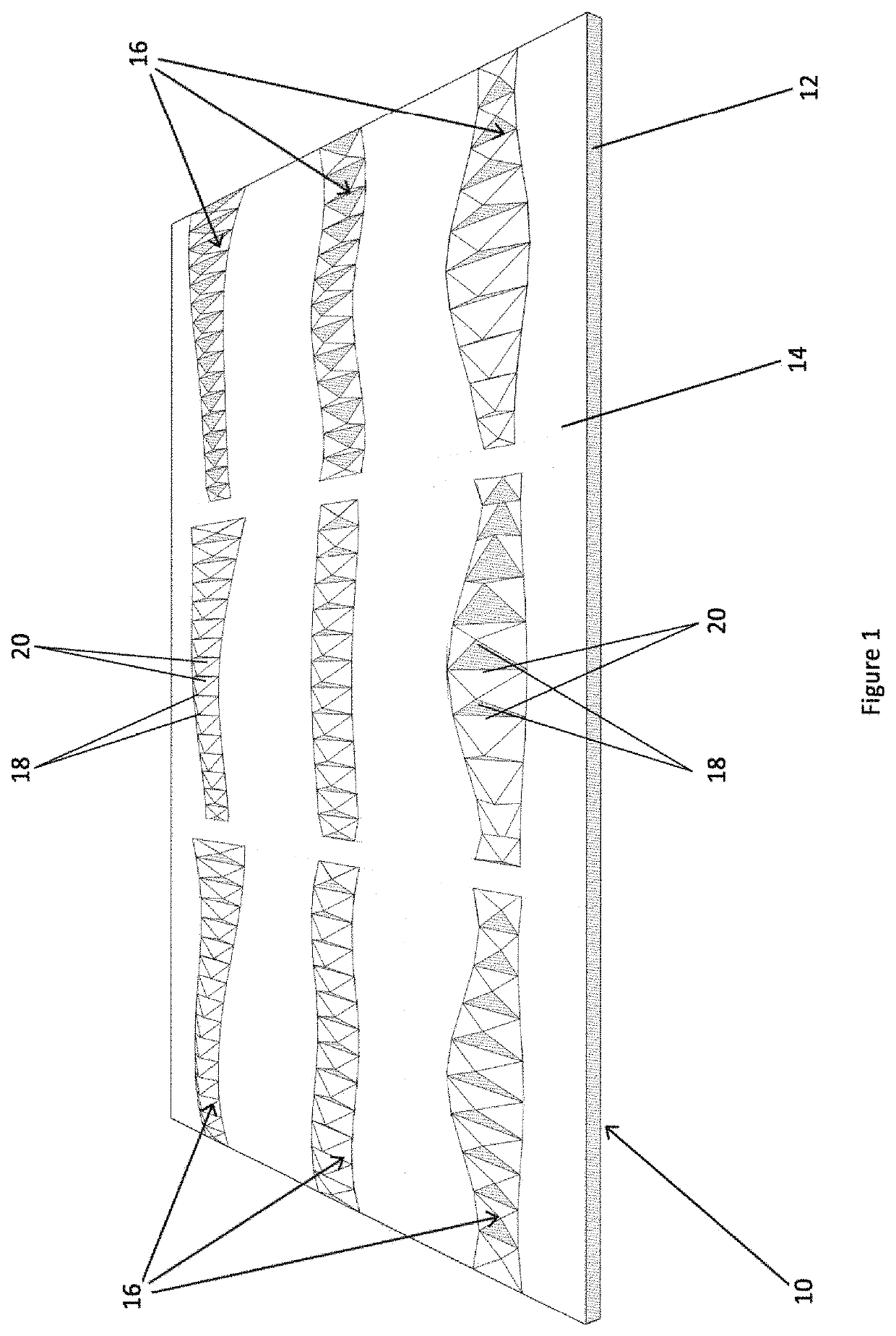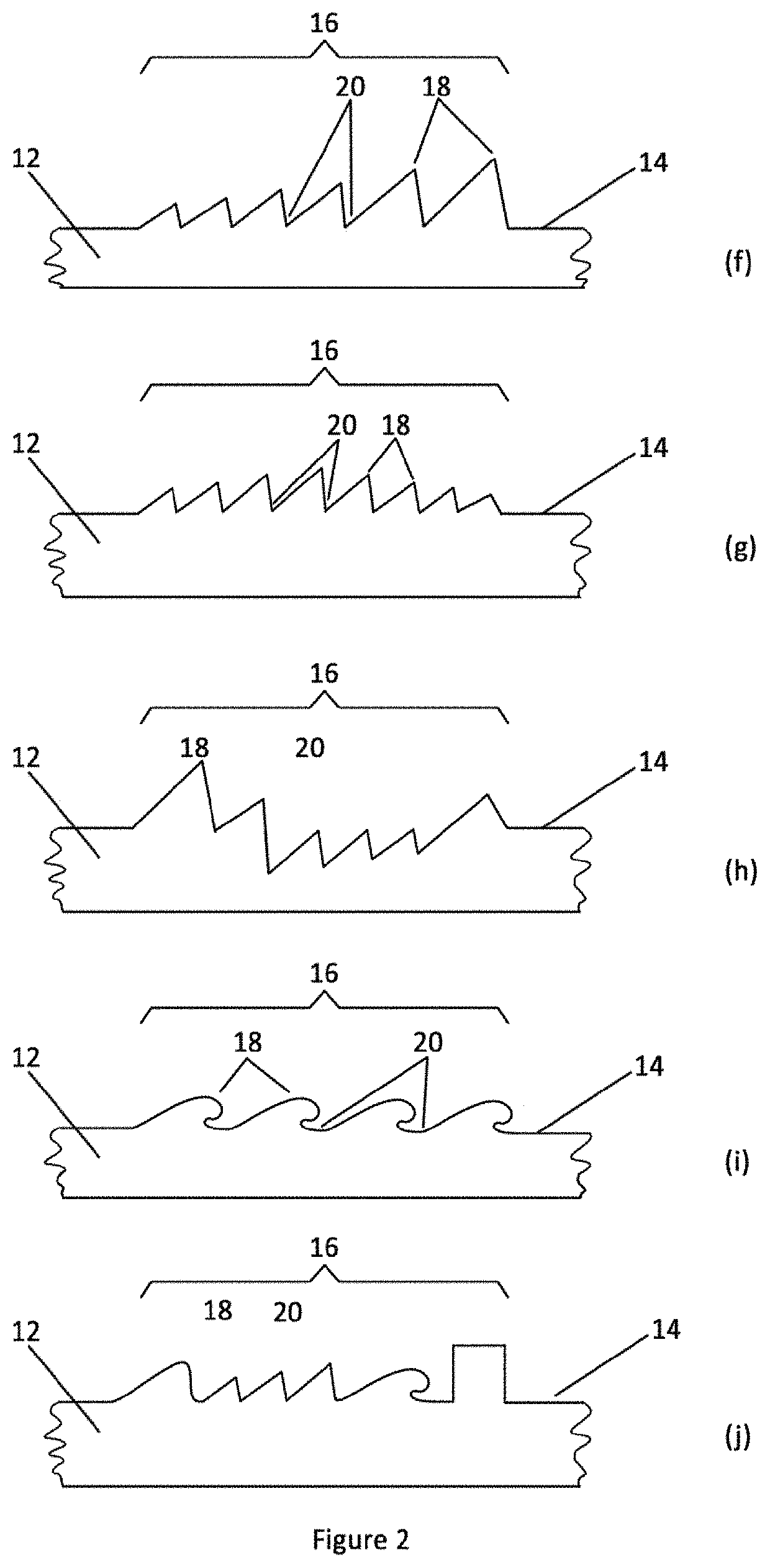[0016]This advantageously provides for enhanced signal detection and distinguishing capabilities and for tailoring the material for particular uses. Specifically, providing a 3D profile provides for regulating a signal to enhance sensing functions on a single uniform surface without the need for additional sensors. It also provides tactile and visual guidance for the user. Additionally, it enables certain movements to be applied to the material e.g. pressing, twisting, squeezing.
[0020]Embodiments of the invention provide for both single point and multiple point sensing. Embodiments of the invention provide for sensing touch position, touch pressure, movement speed, movement direction and touch location or proximity to a measurement sensing location. Multi-touch interactions may be improved by modulating the conductive material e.g. using a spray coating to modulate the surface and / or by varying the conductivity of the material in different areas, e.g. by varying quantity of conductive particles in the silicone. A multi-touch zooming function could be achieved by pressing into the soft material.
[0023]Aspects and / or embodiments of the invention advantageously provide a sensor or tactile interface that can be made to any three-dimensional form with a single material. In its simplest form, a single, possibly uniform, material may be provided for relatively simple functions. In some embodiments, a thin layer of material with a conductive coating on one side may be used, or a conductive module may be cast and a non-conductive filler provided over it. These embodiments still embody the idea of having a body of material that itself is the sensor. In all aspects and / or embodiments, no separate sensing components (e.g. underlying sensor arrays) are required. Embodiments of the invention thus facilitate interactions with high fidelity, whilst the sensor device itself is simple and inexpensive to manufacture. The sensor device also provides enhanced design possibilities and user experience. The invention provides a sensing medium, and especially a capacitive sensing medium, that simulates touch pressure, location, movement speed, movement direction and touch location or proximity from the sensing location.
[0027]The computer program may be provided on a computer readable medium, which may be a physical computer readable medium, such as a disc or a memory device, or may be embodied as a transient signal. Such a transient signal may be a network download, including an internet download. In some aspects and / or embodiments, if a person moves their finger against a three-dimensionally formed material, the capacitive signal graph simulates the pressure of the touch and the 3D form provides a tactile feedback to the person. An initial signal sequence through a short period of time may be sampled to interpret touch location, then the real-time signal can simulate pressure sensing. In other aspects and / or embodiments, when a person moves their finger across a textured three-dimensional surface, the capacitance signal graph resembles or approximates or can be interpreted to describe the geometry condition. The geometry can be modelled in CAD software and then put into a parametric program (e.g. grasshopper) to adjust the teeth angle, height and density. The signals are thus repeatable and programmable such that the software is able to compare a measured signal with a pre-modelled signal waveform and, where there is a match, indicate information to a user such as the location of touch on the material surface, the direction of movement across the surface, the pressure or force a person uses etc. Other algorithms may also be used to detect the movement direction, touch speed and position. For example, the movement speed can be calculated by calculating the distance between the signal change peaks frequency. Movement direction can be detected by comparing the peak value changes, and location can be detected based on the relative displacement. Here, the user does not have to finish the swiping motion on a single texture unit to interact.
[0031]Embodiments of the invention have various advantages. The ability to make a sensor from a single material or the interface material itself without the need for additional sensor pads etc. provides for a much simpler assembly process, minimises material usage and reduces electronic waste. The manufacturing process is therefore a lot more cost effective. Embodiments of the invention achieve a signal processing interface without the need for complicated sensor arrays and the associated calibration procedures. User testing also revealed the notion of the device having the ability to associate a feeling with an action due to the enhanced tactility of the sensor in comparison to known devices.
[0032]A traditional keyboard or touch sensing track pad is typically made of more than 300 parts, which may need to be sourced from multiple suppliers. Assembling a traditional keyboard or touch sensing track pad is laborious due to the high number of components used. In addition, from the point of view of recycling and downgrading, this involves difficult material separation and a high cost dissembling and recycling process (involving chemical separation processes). A quantum tunneling composite might require a mixing process with a much higher production cost / retail price, and can only perform as a single pressure-sensing switch element. Sustainability is challenging due to the information needed to separate the quantum particle content. Embodiments of the present invention, on the other hand, merely require a one-part moulding process with a consequentially lower production cost. Advantageously, they can perform much more complicated sensing functions on one uniform surface. The device is designed for material separation and has a low cost dissembling process. Advantageously, embodiments of the invention require inly low labour involvement and a simple physical detach dissembling process.
 Login to View More
Login to View More  Login to View More
Login to View More 


